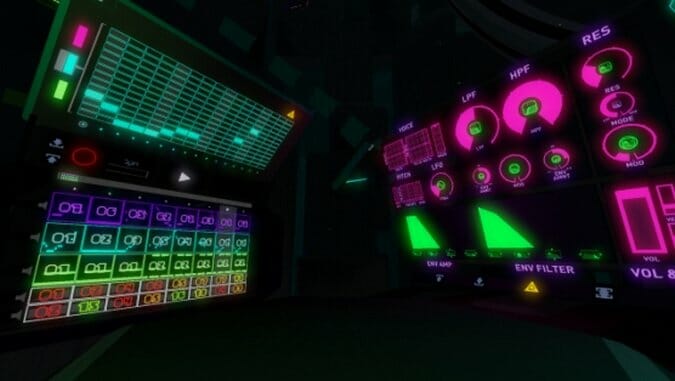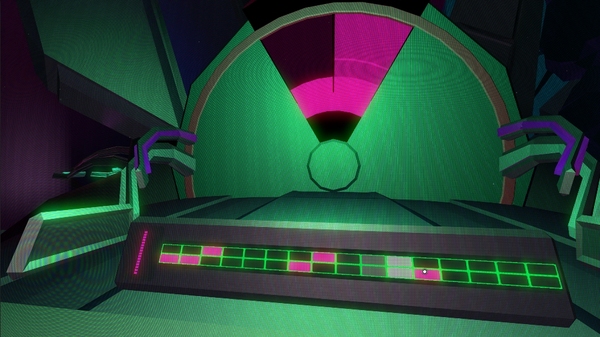
There’s a chapter in How Music Works where David Byrne explains how the evolution of popular music is directly affected by the venue it’s meant to inhabit. For example: Traditional African drumming styles are loud and rapid because they were developed in wide-open fields, whereas music for pipe organs is steady, using gradual chord changes to accommodate reverb-heavy church settings, where more rapid beats would get muddled. Similarly, disco recordings in the late 1970s incorporated synthesizers and deep bass sounds to take advantage of the hi-fi sound systems of disco clubs—and as high quality sound equipment has become widely available outside of the club setting, so have the means of sound production. So for every two MacBooks sold, there’s one “laptronica” music producer with a Soundcloud profile. Electronic music is to the digital landscape what folk songs were to the American frontiers, and MacBooks are the acoustic guitars.
Fract OSC, a new music game from Phosfield Systems, has been on the market for about a week now, and to roughly half its prospective audience—that is, anyone trying to play it on a MacBook—it’s a guitar with half its strings missing. For everyone else, Fract is a dazzling visual representation of digital music’s frontier. Players wander through a silent, uninhabited world punctuated with abandoned technological marvels, which the player works to reawaken at his or her will, part open-world first-person puzzler, part virtual synthesizer.
Dispelling the silence is what drives players forward. The overworld is filled with breathtaking sights: towering, fractal mountains and hills stand beside gaping canyons washed in an ambient, neon glow, with static pieces of machinery stalled in mid-orbit. But traveling through it between puzzles is a lonely journey indeed. Fract is a game about sound, but quiet is its biggest asset: by providing players with no traveling companion other than the hum of dormant machinery, Fract taps into their primal social instincts, subconsciously driving them to seek solace in whatever tones and rhythms they can tug out of the machines.
But if you’re a Mac user, like me and everyone else seeking help through Phosfield’s forums, frustrating silence and chaos is all you’ll manage, because Fract is practically unplayable past its first fifteen minutes. Any time a good deal of action is happening onscreen (which is a lot of the time), the game’s audio sticks and stutters along with the framerate, in spite of any tinkering with in-game settings meant to rectify the situation. And since every one of Fract’s puzzles is a hyperkinetic experience (imagine if the spaceship from Close Encounters of the Third Kind had a baby with a light cycle from Tron), the bits of Fract that are meant to inspire childlike wonder and playfulness instead cause motion sickness and tinnitus.
One early puzzle involves using an in-game step sequencer to propel a stack of large rings from the ground to a designated point in the air. Each ring in the stack corresponds with a row on the sequencer, and every beat programmed into a row gives the corresponding ring a boost. The player has a limited number of beats that they can program into the sequencer, and each ring rises and falls from its boost at a different speed; the player must figure out how to get all of the rings up to the designated point without one ring dropping onto the one below it. Rhythm is crucially important here, and the game can’t keep a beat even when I haven’t input anything into the sequencer. It’s like trying to play in a band whose drummer has to stop and think after every measure. “1, 2, 3, 4, 1, 2, 3, 4, 1, 2, 3, 4” shouldn’t be hard to manage, but on a Mac Fract keeps stepping on its own toes.
Another puzzle has nothing to do with sound, simply requiring me to move large cubes across a grid overlaid in the space in front of me. Simple enough: Move one cube directly in front of me so that I can cross a gap, and then, from my new perspective, move some other cubes into the glowing spaces to solve the puzzle. But the rhythmic flashing and chiming of the cubes are so cluttered when they come out of my headphones that I have to mute the game in order to concentrate.
The majority of the people I know who were anticipating this game are sound geeks. They’re composers, sound designers, music fans. Myself, I rock a pair of Grado SR-80s, was born with perfect pitch, and have practiced music in various capacities for thirteen years. I use a MacBook and so does just about anyone who works with music. It baffles me that Phosfiend Systems wouldn’t properly ensure that the audience who would most appreciate Fract would get a working product.
As a gamer I understand the probable absurdity in complaining that a game doesn’t work as well on a Mac as it would on a PC. But as both a music-lover and an everyday consumer, I expect more. Indie developers in particular should be aware that not everyone in their audience can afford a pricey, specialized gaming rig, especially when their game specifically appeals to people who wouldn’t. Otherwise, you’re trying to fit a whole symphony orchestra onto a dance floor—without leaving any room for the dancers.
Fract was developed by Phosfiend Systems. Our review is based on the Mac version. We will have thoughts on the PC version soon.
Nicholas Milanes is a contributor to Paste and Kill Screen.
